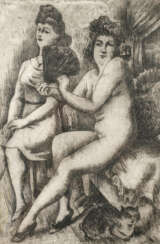dressler

Adolf Dressler, a German landscape painter, is considered the founder of Silesian landscape painting.
Adolf Dressler devoted his work mainly to the Silesian landscape. In 1879 he was appointed head of the landscape painting workshop in Breslau at the newly founded Museum of Fine Arts.


Adolf Dressler, a German landscape painter, is considered the founder of Silesian landscape painting.
Adolf Dressler devoted his work mainly to the Silesian landscape. In 1879 he was appointed head of the landscape painting workshop in Breslau at the newly founded Museum of Fine Arts.


August Wilhelm Dressler was a German artist and proponent of the New Objectivity.
Dressler studied at the Dresden Art Academy, then at the Academy of Graphic Arts and Book Trade in Leipzig. In Berlin, he joined the November Group and in 1924 became a member of the Berlin Secession. From 1934, Dressler taught at the Berlin State School, from which he was expelled in 1938 as a "degenerate artist". In 1937, during the Nazi "Degenerate Art" campaign, Dresler's works were confiscated and many were lost.
After World War II, the artist resumed exhibitions in Berlin, and in 1956 was offered a teaching position at the Higher School of Applied Arts in West Berlin. Dressler left behind an extensive body of work in painting and drawing, of particular importance are his numerous portraits and depictions of women.


August Wilhelm Dressler was a German artist and proponent of the New Objectivity.
Dressler studied at the Dresden Art Academy, then at the Academy of Graphic Arts and Book Trade in Leipzig. In Berlin, he joined the November Group and in 1924 became a member of the Berlin Secession. From 1934, Dressler taught at the Berlin State School, from which he was expelled in 1938 as a "degenerate artist". In 1937, during the Nazi "Degenerate Art" campaign, Dresler's works were confiscated and many were lost.
After World War II, the artist resumed exhibitions in Berlin, and in 1956 was offered a teaching position at the Higher School of Applied Arts in West Berlin. Dressler left behind an extensive body of work in painting and drawing, of particular importance are his numerous portraits and depictions of women.


August Wilhelm Dressler was a German artist and proponent of the New Objectivity.
Dressler studied at the Dresden Art Academy, then at the Academy of Graphic Arts and Book Trade in Leipzig. In Berlin, he joined the November Group and in 1924 became a member of the Berlin Secession. From 1934, Dressler taught at the Berlin State School, from which he was expelled in 1938 as a "degenerate artist". In 1937, during the Nazi "Degenerate Art" campaign, Dresler's works were confiscated and many were lost.
After World War II, the artist resumed exhibitions in Berlin, and in 1956 was offered a teaching position at the Higher School of Applied Arts in West Berlin. Dressler left behind an extensive body of work in painting and drawing, of particular importance are his numerous portraits and depictions of women.


August Wilhelm Dressler was a German artist and proponent of the New Objectivity.
Dressler studied at the Dresden Art Academy, then at the Academy of Graphic Arts and Book Trade in Leipzig. In Berlin, he joined the November Group and in 1924 became a member of the Berlin Secession. From 1934, Dressler taught at the Berlin State School, from which he was expelled in 1938 as a "degenerate artist". In 1937, during the Nazi "Degenerate Art" campaign, Dresler's works were confiscated and many were lost.
After World War II, the artist resumed exhibitions in Berlin, and in 1956 was offered a teaching position at the Higher School of Applied Arts in West Berlin. Dressler left behind an extensive body of work in painting and drawing, of particular importance are his numerous portraits and depictions of women.


August Wilhelm Dressler was a German artist and proponent of the New Objectivity.
Dressler studied at the Dresden Art Academy, then at the Academy of Graphic Arts and Book Trade in Leipzig. In Berlin, he joined the November Group and in 1924 became a member of the Berlin Secession. From 1934, Dressler taught at the Berlin State School, from which he was expelled in 1938 as a "degenerate artist". In 1937, during the Nazi "Degenerate Art" campaign, Dresler's works were confiscated and many were lost.
After World War II, the artist resumed exhibitions in Berlin, and in 1956 was offered a teaching position at the Higher School of Applied Arts in West Berlin. Dressler left behind an extensive body of work in painting and drawing, of particular importance are his numerous portraits and depictions of women.












































































